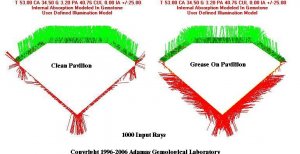adamasgem
Brilliant_Rock
- Joined
- May 23, 2003
- Messages
- 1,338
Boy Garry, you can't take a joke.. Anyway, this should save you the time to try to prove a proven point.Date: 12/20/2006 2:09:28 AM
Author: Garry H (Cut Nut)
Not sure if i can really dig you guys
One of you has a sick sense of humour, and the other is spraying butt's with oil ????????????????
This is the effect (in 2D) of a layer of grease (RI~1.5) on the pavillion, similar to a layer of cooking oil on the pavilion..
1000 input rays distributed uniformly +/- 25 degrees from table normal (high angle lighting)
Dark Green is reflected ray
Light Green is refracted ray from internal to the diamond
RED is refracted light loss through the pavailion
Grease, cooking oil, body oil, all have about the same RI.
The red is the pavilion light loss..The increased light loss out of the pavilion is why diamonds get dull when they accumulate gunk on the pavilion of the stone.
CLEAN YOUR DIAMONDS.. NEED I SAY MORE..





300x240.png)